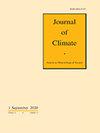与公海相比,近海岸地区热带气旋引起的海洋冷却更强
IF 4.8
2区 地球科学
Q1 METEOROLOGY & ATMOSPHERIC SCIENCES
引用次数: 0
摘要
热带气旋(TC)经常在上层海洋引起强烈的混合,在其尾迹中产生较低的海面温度(Twake)。Twake可以影响TC的强度,因此它的预测很重要,特别是在TC可能登陆的沿海地区。由于海岸线几何形状、高度变化的水深、大陆径流和陆架过程的影响,沿海地震往往比开阔海域的地震更为复杂。利用2002年以来的观测数据,我们发现全球沿海地区的平均Twake明显强于近海地区。温度分层是北大西洋和东太平洋沿岸强烈地震的主要驱动因素。在西北太平洋和北印度洋,由于TC强迫和海洋分层之间的补偿,沿海和近海地震之间的差异较小。北印度洋在北半球是独一无二的,因为盐度分层对Twake的空间分布起着重要作用。在南太平洋,TC强度和平移速度对解释海岸-近海Twake差异至关重要,而海洋分层和混合层深度对解释南印度洋海岸-近海Twake差异更为重要。这些发现表明,为了捕捉风暴接近登陆时由tc引起的海洋冷却的变化,需要在模型中适当地表示海洋分层的沿海和近海差异。登陆的热带气旋(TCs)经常在人口密集的沿海地区造成相当大的破坏。了解TC -海洋相互作用以及沿海和近海地区之间的差异有助于在登陆前预测TC强度。TC通过后海面冷却是TC - ocean相互作用的重要表征。尚未对沿海tc引起的冷却进行全球评估。利用覆盖20年的数据,我们发现,在全球范围内,除了西北太平洋和北印度洋以外,沿海地区和所有盆地的tc诱发的地表冷却明显强于近海地区。这种差异主要是由北大西洋、东太平洋和南印度洋的上层海洋条件以及南太平洋的TC特征驱动的。本文章由计算机程序翻译,如有差异,请以英文原文为准。
Stronger Tropical Cyclone–Induced Ocean Cooling in Near-Coastal Regions Compared to the Open Ocean
Tropical cyclones (TC) often induce strong mixing in the upper ocean that generates a trail of cooler sea surface temperature (Twake) in their wakes. The Twake can affect TC intensity, so its prediction is important, especially in coastal regions where TCs can make landfall. Coastal Twakes are often more complex than those in the open ocean due to the influences of coastline geometry, highly variable water depth, continental runoff, and shelf processes. Using observational data since 2002, here we show a significantly stronger global mean Twake in coastal regions compared to offshore regions. Temperature stratification is the main driver of stronger coastal Twakes in the North Atlantic and east Pacific. In the northwest Pacific and north Indian Ocean, the differences between coastal and offshore Twakes are smaller due to compensation between TC forcings and ocean stratification. The north Indian Ocean is unique in the Northern Hemisphere because salinity stratification plays a major role on the spatial distribution of Twake. In the South Pacific Ocean, TC intensity and translation speed are crucial for explaining coastal–offshore Twake differences, while ocean stratification and mixed layer depth are more important for the coastal–offshore Twake differences in the south Indian Ocean. These findings suggest that coastal–offshore differences in ocean stratification need to be properly represented in models in order to capture changes in TC-induced ocean cooling as storms approach landfall.
Landfalling tropical cyclones (TCs) often cause considerable damage in coastal regions with dense human populations. Understanding TC–ocean interaction and how it differs between coastal and offshore regions can help predict TC intensity prior to landfall. Sea surface cooling after TC passage is an important proxy for TC–ocean interaction. A global evaluation of coastal TC-induced cooling has not been conducted. Using data covering two decades, we show significantly stronger TC-induced surface cooling in coastal regions compared to offshore regions at the global scale and in all basins except the northwest Pacific and north Indian Ocean. The difference is driven mainly by upper-ocean conditions in the North Atlantic, east Pacific, and south Indian Ocean, and by TC characteristics in the South Pacific.
求助全文
通过发布文献求助,成功后即可免费获取论文全文。
去求助
来源期刊

Journal of Climate
地学-气象与大气科学
CiteScore
9.30
自引率
14.30%
发文量
490
审稿时长
7.5 months
期刊介绍:
The Journal of Climate (JCLI) (ISSN: 0894-8755; eISSN: 1520-0442) publishes research that advances basic understanding of the dynamics and physics of the climate system on large spatial scales, including variability of the atmosphere, oceans, land surface, and cryosphere; past, present, and projected future changes in the climate system; and climate simulation and prediction.
 求助内容:
求助内容: 应助结果提醒方式:
应助结果提醒方式:


